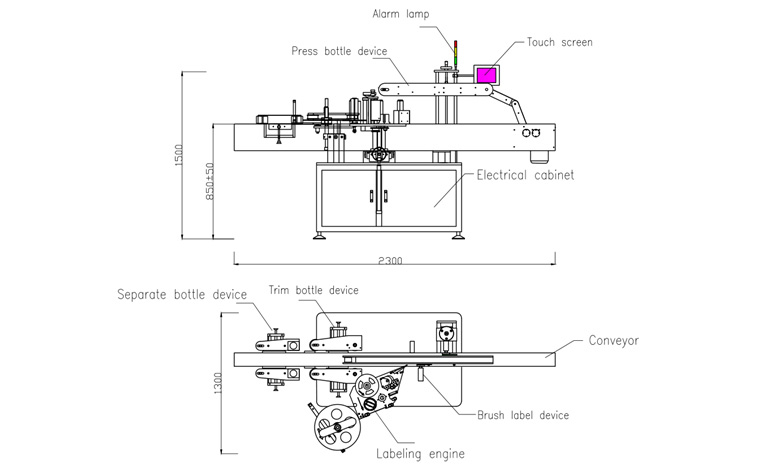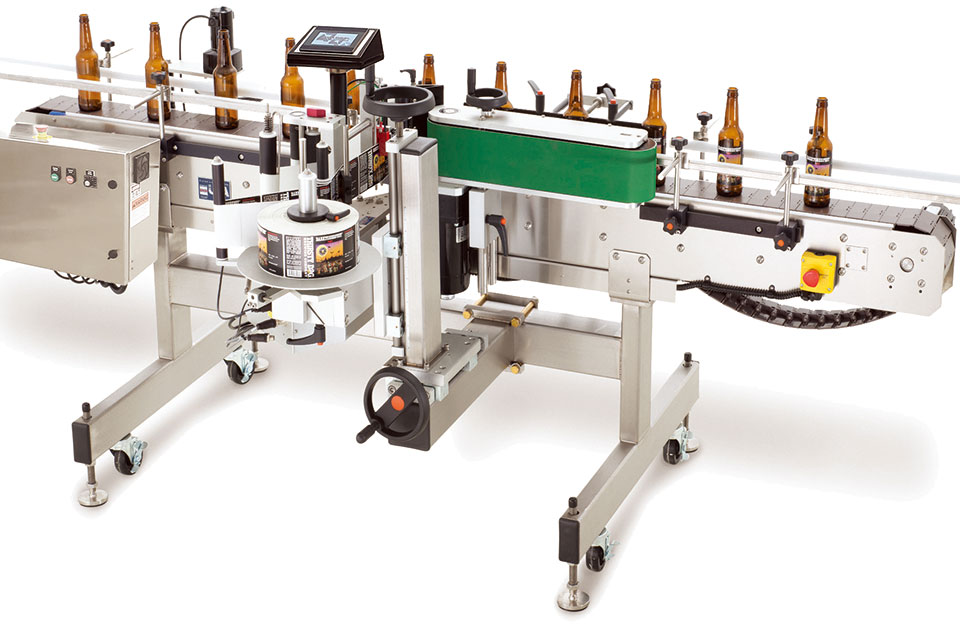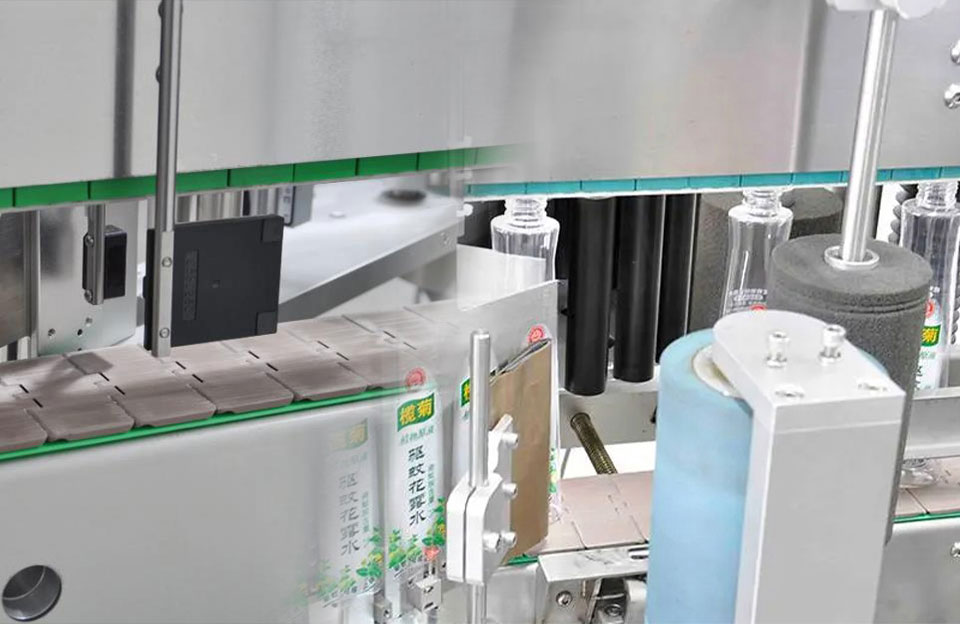The conveyor system plays a vital role in labeling machines and is essential for efficient and accurate labeling. The conveyor system in labeling machine ensures a consistent and uninterrupted product flow. It minimizes labeling errors and reduces label waste with precise product positioning and consistent labeling.
The Function of Conveyor System in Labeling Machine
The function of the conveyor system in labeling machine is to transport products through the labeling process in a controlled and efficient manner. The conveyor system plays a critical role in the overall labeling process, and its functions include:
- Product Alignment: The conveyor system in labeling machine ensures the products are properly aligned and positioned through machine. Proper alignment is crucial to ensure accurate and consistent label placement on each product.
- Continuous Product Flow: The conveyor system maintains a steady and continuous flow of products through the labeling machine. This helps optimize the labeling process and ensures a consistent labeling speed without interruptions.
- Product Separation: In cases where products are closely spaced on the production line, the conveyor system separates them adequately to allow sufficient space for labeling. This prevents label overlapping and misapplication.
- Label Application: The conveyor system brings the products to the labeling station where the labels are applied. The labeling machine’s mechanism is synchronized with the conveyor’s movement to ensure precise and synchronized label application on each product.
- Label Detection and Verification: Some conveyor systems in labeling machine are equipped with sensors to detect the presence of products or labels. This helps ensure that products without labels or with misapplied labels are rejected or flagged for manual inspection.
- Speed and Position Control: The conveyor system’s speed can be adjusted to match the labeling machine’s capabilities and the production line’s requirements. The conveyor system can also be programmed to stop or slow down when needed to accommodate maintenance, jams, or other production issues.
- Integration with Other Equipment: The conveyor system allows seamless integration of the labeling machine with other production line equipment, such as filling machines, capping machines, or packaging machines. This integration optimizes the overall production process.
- Quality Control and Rejection: In some cases, the conveyor system in labeling machine is equipped with quality control mechanisms that inspect the labels or products during the labeling process. Defective or non-compliant products can be automatically rejected or diverted for manual inspection.
- Ergonomics and Labor Efficiency: By automating the movement of products, the conveyor system in labeling machine reduces the need for manual handling and minimizes the physical strain on workers. This improves ergonomics and overall labor efficiency.
- Versatility: Conveyor system in labeling machine can be designed to handle various product shapes, sizes, and materials. It can be customized to suit the specific requirements of different industries and labeling applications.

Structure of Labeling Machine
How to Keep Conveyor System in Labeling Machine Running Smoothly?
Regular maintenance and proper operational practices are essential to keep the conveyor system in labeling machine running smoothly and efficiently. Here are some tips for maintaining a smooth-running conveyor system:
- Routine Inspection: Regularly inspect the conveyor system for signs of wear, damage, or misalignment. Check for loose bolts, worn-out components, and damaged belts. Please address any issues promptly to prevent them from escalating into major problems.
- Lubrication: Keep the conveyor’s moving parts well-lubricated according to the manufacturer’s guidelines. Proper lubrication reduces friction, wear, and noise, extending the life of the conveyor system.
- Cleaning: Clean the conveyor system regularly to remove dust, debris, and accumulated material. Buildup on the conveyor can lead to misalignment, decreased efficiency, and increased wear and tear.
- Tension Adjustment: Ensure the conveyor belts or chains have the correct tension. Loose belts can slip and cause misalignment, while overly tight belts can lead to premature wear.
- Proper Loading: Do not overload the conveyor system beyond its capacity. Excessive weight can strain the motor and other components, leading to breakdowns.
- Training and Maintenance Protocols: Train employees on how to operate and maintain the conveyor system correctly. Establish maintenance protocols and schedules to ensure regular upkeep.
- Safety Measures: Implement safety measures to protect operators and prevent accidents. Provide proper guarding, emergency stops, and safety interlocks to ensure the conveyor system is used safely.
- Monitoring and Control: Install monitoring systems to track the conveyor’s performance and identify potential real-time issues. Automated control systems can help regulate the conveyor’s speed and alignment.
- Spare Parts Inventory: Maintain an inventory of critical spare parts. This allows for quick replacements in case of unexpected breakdowns, reducing downtime.
- Professional Servicing: Engage the services of experienced technicians or conveyor system specialists for periodic inspections and maintenance. They can provide expert advice and ensure the conveyor system is in optimal condition.
- Addressing Problems Promptly: If any issues or abnormalities are detected during operation, address them immediately. Ignoring problems can lead to more significant and costly breakdowns in the future.
- Proper Training for Operators: Ensure that the operators handling the conveyor system are adequately trained. They should be familiar with its functions, safety measures, and troubleshooting techniques.
Conclusion
Conveyor systems are indispensable components of labeling machines that significantly enhance efficiency, accuracy, and productivity. They streamline the labeling process, reduce errors, and enable seamless integration with other production line equipment, making them a vital part of modern manufacturing and packaging operations.
By following these guidelines and maintaining conveyor system regularly, labeling machine can maintain smooth, trouble-free operation, increasing productivity, reducing downtime, and extending the life of conveyor system.


